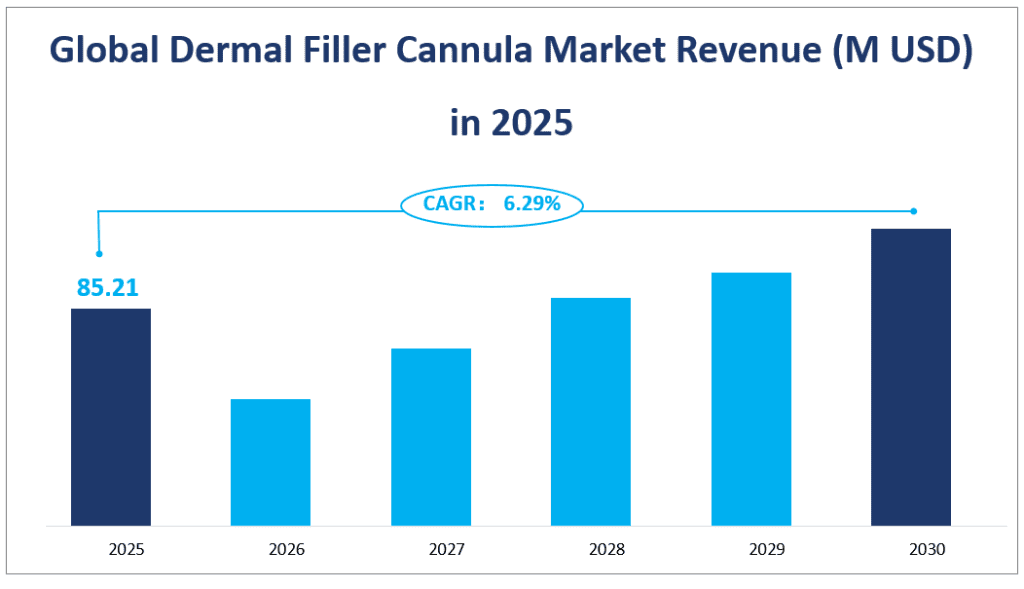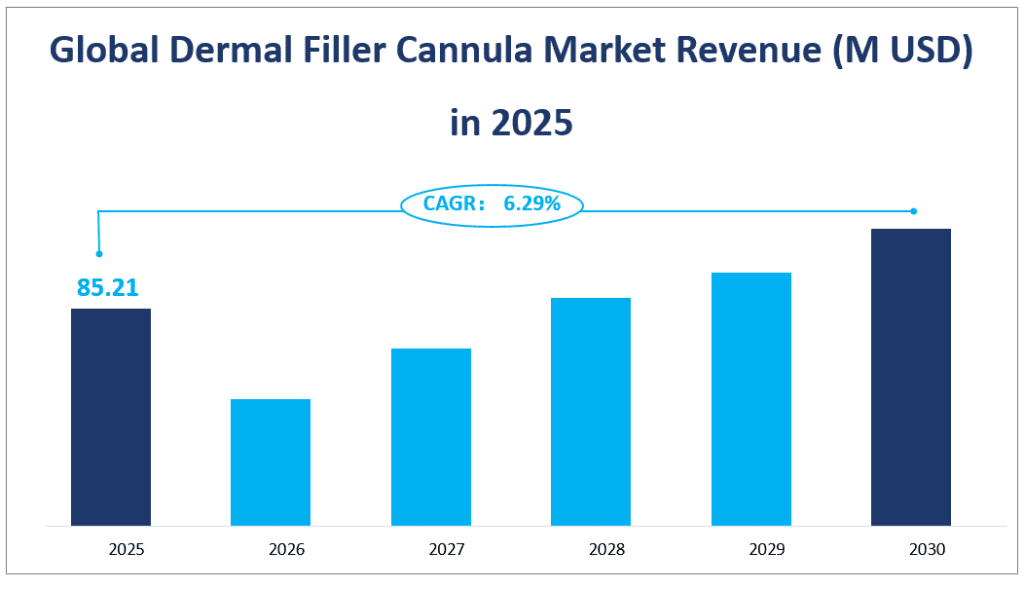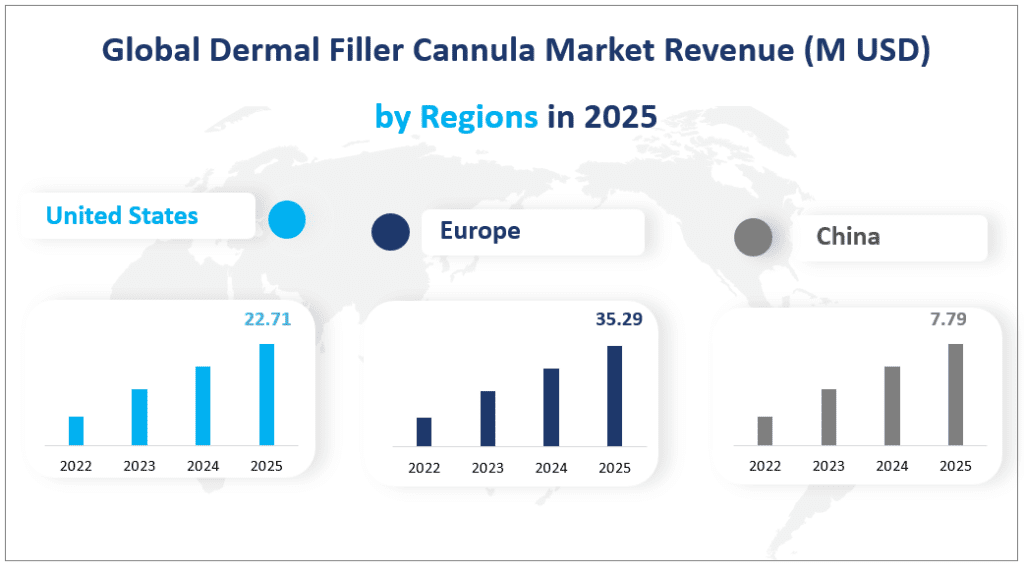1. Global Dermal Filler Cannula Market Definition
The global dermal filler cannula market is projected to reach a revenue of $85.21 million in 2026 with a CAGR of 6.29% from 2025 to 2030. This growth is driven by increasing demand from downstream industries, technological innovations, and the rising popularity of aesthetic procedures globally.
A dermal filler cannula is a specialized medical device used for injecting dermal fillers into the skin. It is designed to facilitate the delivery or removal of fluids and is particularly used in aesthetic and surgical procedures. The primary function of a dermal filler cannula is to provide a safer and more effective alternative to traditional needles, reducing the risk of complications such as bruising and vascular occlusion. The cannula’s flexibility and precision make it ideal for various applications, including facial rejuvenation, wrinkle reduction, and non-surgical rhinoplasty.
Global Dermal Filler Cannula Market Revenue (M USD)


2. Driving Factors of Dermal Filler Cannula Market
The growth of the dermal filler cannula market is influenced by several key factors. On one hand, the market benefits from increasing consumer acceptance of aesthetic procedures, driven by popular culture and the influence of celebrities. The rise in disposable income and the availability of more affordable procedures have also contributed to the market’s expansion. Additionally, the development of medical beauty insurance and the introduction of installment payment options have lowered the barriers to entry for consumers, further fueling demand.
Technological advancements have played a crucial role in the market’s growth. Innovations in cannula design and manufacturing have led to safer and more effective devices, reducing the risk of complications and improving patient outcomes. The increasing popularity of non-surgical aesthetic procedures, such as facial rejuvenation and wrinkle reduction, has also driven the demand for dermal filler cannulas.
3. Limiting Factors of Dermal Filler Cannula Market
However, the market also faces several limiting factors. The high technical barriers and regulatory requirements associated with medical devices pose significant challenges for new entrants. The development and certification process for dermal filler cannulas is lengthy and complex, requiring substantial investment in research and development. Additionally, the market is highly concentrated, with a few major players dominating the industry. This concentration limits competition and can stifle innovation.
Another limiting factor is the availability of qualified medical professionals. The number of certified plastic surgeons and aesthetic practitioners is relatively low, particularly in developing regions. This shortage can restrict the market’s growth, as the demand for procedures outstrips the capacity of available professionals.
4. Analysis of Dermal Filler Cannula Market Segment
Product Types
The global dermal filler cannula market is segmented into two primary product types: Flexibility Cannulas and Rigidity Cannulas. These types differ in their design, application, and market dynamics, each catering to specific needs within the aesthetic and surgical fields.
Flexibility Cannulas: These cannulas are expected to generate a revenue of $79.45 million by 2025. Flexibility cannulas dominate the market, accounting for the majority of the total revenue. Their popularity stems from their versatility and reduced risk of complications compared to traditional needles. Flexibility cannulas are widely used in beauty care applications, such as facial rejuvenation, wrinkle reduction, and non-surgical procedures. Their ability to glide smoothly under the skin minimizes bruising and ensures precise filler placement, making them a preferred choice for both practitioners and patients.
Rigidity Cannulas: These cannulas are projected to generate a revenue of $5.77 million in 2025. While they hold a smaller market share compared to flexibility cannulas, rigidity cannulas are essential for specific surgical procedures where more control and precision are required. They are commonly used in applications such as eyelid surgery, facial reshaping, and other surgical interventions where a rigid structure is necessary for accurate injections.
Dermal Filler Cannula Market by Applications
The dermal filler cannula market is also segmented by its applications, primarily divided into Beauty Care and Surgery. These applications differ in their market dynamics, revenue generation, and growth potential, reflecting the diverse needs of the aesthetic and medical industries.
Beauty Care: This segment is projected to generate a consumption volume of 30131.5 K Units in 2025. Beauty care applications include a wide range of non-surgical aesthetic procedures such as facial rejuvenation, wrinkle reduction, and fat-dissolving injections. The growing popularity of these procedures, driven by increasing consumer demand for non-invasive treatments, has significantly contributed to the market’s expansion.
Surgery: The surgical application segment is expected to generate a consumption volume of 4791.4 K Units in 2025. Surgical applications include procedures such as eyelid surgery, facial reshaping, and other plastic surgeries where dermal filler cannulas are used for precise filler placement. While the market size for surgical applications is smaller compared to beauty care, it remains a critical segment due to the specialized nature of these procedures.
The beauty care segment’s dominance in the dermal filler cannula market can be attributed to several key factors. Firstly, the increasing consumer acceptance of aesthetic procedures, driven by popular culture and the influence of celebrities, has significantly contributed to the segment’s growth. Consumers are increasingly seeking non-surgical treatments to achieve a more youthful appearance with minimal downtime. Secondly, the development of medical beauty insurance and installment payment options has made these procedures more accessible, further fueling demand.
Market Revenue by Segment
| Revenue (M USD) in 2025 | ||
| By Type | Flexibility Cannula | 79.45 |
| Rigidity Cannulas | 5.77 | |
| Consumption Volume (K Units) in 2025 | ||
| By Application | Beauty Care | 30131.5 |
| Surgery | 4791.4 |
5. Regional Dermal Filler Cannula Market
Europe: Europe remains the largest dermal filler cannula market by revenue, with a projected value of $35.29 million in 2025. This region has historically dominated the dermal filler cannula market. The market’s strength in Europe can be attributed to the high demand for aesthetic procedures, advanced healthcare infrastructure, and a strong presence of leading manufacturers.
United States: The United States is the second-largest market, with a projected value of $22.71 million in 2025. The U.S. market benefits from a high level of consumer awareness and acceptance of aesthetic procedures, as well as a robust healthcare system that supports advanced medical technologies. The growth of the U.S. market is also driven by the increasing popularity of non-surgical treatments and the continuous innovation in cannula technology.
China: China is emerging as a significant player in the dermal filler cannula market, with a projected value of $7.79 million in 2025. The rapid growth of the Chinese market is fueled by increasing consumer demand for aesthetic procedures, rising disposable incomes, and the expansion of the medical aesthetics industry. China’s market is expected to grow at a robust rate, driven by technological advancements and policy support from the government.
Japan: Japan is another key market, with a projected value of $5.11 million in 2025. The Japanese market is characterized by a high level of technological sophistication and a strong focus on quality and safety. The growth of the Japanese market is driven by the increasing demand for aesthetic procedures and the continuous innovation in medical devices.
Europe remains the largest market by revenue. Europe’s dominance is attributed to its advanced healthcare infrastructure, high consumer demand for aesthetic procedures, and the presence of leading manufacturers.
The fastest-growing region is expected to be China, driven by the rapid expansion of the medical aesthetics industry, increasing disposable incomes, and rising consumer awareness of aesthetic procedures. China’s market is projected to grow at a robust rate, making it a key region to watch in the coming years.
Global Dermal Filler Cannula Market Revenue (M USD) by Regions in 2025


6. Analysis of the Top 3 Companies in the Dermal Filler Cannula Market
TSK is a leading manufacturer of dermal filler cannulas, established in 1948. The company is headquartered in Japan and operates globally, with manufacturing bases in Japan and offices in Canada, the Netherlands, China, and other regions. TSK is renowned for its high-quality standards and commitment to patient safety. All of its facilities and ISO-certified cleanrooms adhere to the highest levels of inspection and auditing standards.
TSK offers a range of dermal filler cannulas, including the STERiGLIDE™ cannula. This product is designed with a patented dome-shaped tip that reduces resistance and minimizes the risk of bruising. The STERiGLIDE™ cannula is widely used in beauty care applications, such as facial rejuvenation and wrinkle reduction.
Cosmofrance, known for its DermaSculpt brand, is a leading manufacturer of high-quality medical devices for aesthetic practitioners. Established in 1997, the company specializes in non-invasive procedures and is headquartered in North America. Cosmofrance is committed to innovation and constantly seeks to introduce new trends that set its customers apart.
Cosmofrance offers a range of dermal filler cannulas, including the DermaSculpt microcannula. This product is designed with a blunt tip that slides smoothly under the skin, reducing the risk of complications. DermaSculpt cannulas are widely used in beauty care applications, such as facial rejuvenation and wrinkle reduction.
Aesthetic Group is a leading manufacturer of medical devices for plastic surgery, aesthetic medicine, and dermatology. Established in 2002, the company is headquartered in Europe and operates globally. Aesthetic Group is known for its high-quality products and commitment to innovation.
Aesthetic Group offers a range of dermal filler cannulas, including the Dispoderm® flexible micro cannula. This product is designed for use with hyaluronic acid fillers and is suitable for a wide range of beauty care applications, such as facial rejuvenation and wrinkle reduction.
The dermal filler cannula market is a dynamic and rapidly growing sector, with significant variations in market value across different regions. Europe remains the largest market by revenue, while China is emerging as the fastest-growing region. The market is highly concentrated, with TSK, Cosmofrance (DermaSculpt), and Aesthetic Group dominating the industry. These companies are known for their innovative products and strong global presence, making them key players to watch in the coming years.
Major Players
| Company Name | Plant Locations | Market Distribution |
| TSK | Japan | Worldwide |
| Cosmofrance (DermaSculpt) | Mainly in North America | Worldwide |
| Aesthetic Group | Mainly in Europe | Worldwide |
| Soft Medical Aesthetics | Mainly in Europe | Worldwide |
| Sterimedix | Mainly in Europe | Worldwide |
| Eclipse Aesthetics | Mainly in North America | Worldwide |
| Dino Medical Instruments | China | Mainly in Asia |
1 Market Overview
1.1 Dermal Filler Cannula Introduction
1.2 Market Analysis by Types
1.2.1 Flexibility Cannula
1.2.2 Rigidity Cannulas
1.3 Market Analysis by Application
1.4 Market Analysis by Regions
1.4.1 United States Market States and Outlook (2014-2026)
1.4.2 Europe Market States and Outlook (2014-2026)
1.4.3 China Market States and Outlook (2014-2026)
1.4.4 Japan Market States and Outlook (2014-2026)
1.4.5 Southeast Asia Market States and Outlook (2014-2026)
1.4.6 India Market States and Outlook (2014-2026)
1.4.7 Brazil Market States and Outlook (2014-2026)
1.4.8 GCC Countries Market States and Outlook (2014-2026)
1.5 Market Dynamics and Development
1.5.1 Merger, Acquisition and New Investment
1.5.2 Market SWOT Analysis
1.5.3 Drivers
1.5.4 Limitations
1.5.5 Opportunities and Development Trends
1.6 Global Dermal Filler Cannula Market Size Analysis from 2014 to 2026
1.6.1 Global Dermal Filler Cannula Market Size Analysis from 2014 to 2026 by Consumption Volume
1.6.2 Global Dermal Filler Cannula Market Size Analysis from 2014 to 2026 by Value
1.6.3 Global Dermal Filler Cannula Price Trends Analysis from 2014 to 2026
1.7 Dermal Filler Cannula Industry Development Trends under COVID-19 Outbreak
1.7.1 Global COVID-19 Status Overview
1.7.2 Influence of COVID-19 Outbreak on Dermal Filler Cannula Industry Development
2 Global Dermal Filler Cannula Competition by Types, Applications, and Top Regions and Countries
2.1 Global Dermal Filler Cannula (Volume and Value) by Type
2.1.1 Global Dermal Filler Cannula Consumption by Type (2014-2019)
2.1.2 Global Dermal Filler Cannula Revenue by Type (2014-2019)
2.2 Global Dermal Filler Cannula (Volume and Value) by Application
2.2.1 Global Dermal Filler Cannula Consumption by Application (2014-2019)
2.2.2 Global Dermal Filler Cannula Revenue by Application (2014-2019)
2.3 Global Dermal Filler Cannula (Volume and Value) by Regions
2.3.1 Global Dermal Filler Cannula Consumption by Regions (2014-2019)
2.3.2 Global Dermal Filler Cannula Revenue by Regions (2014-2019)
3 United States Dermal Filler Cannula Market Analysis
3.1 United States Dermal Filler Cannula Consumption and Value Analysis
3.2 United States Dermal Filler Cannula Consumption Volume by Types
3.3 United States Dermal Filler Cannula Consumption Structure by Application
4 Europe Dermal Filler Cannula Market Analysis
4.1 Europe Dermal Filler Cannula Consumption and Value Analysis
4.2 Europe Dermal Filler Cannula Consumption Volume by Types
4.3 Europe Dermal Filler Cannula Consumption Structure by Application
4.4 Europe Dermal Filler Cannula Consumption by Top Countries
4.4.1 Germany Dermal Filler Cannula Consumption Volume from 2014 to 2019
4.4.2 UK Dermal Filler Cannula Consumption Volume from 2014 to 2019
4.4.3 France Dermal Filler Cannula Consumption Volume from 2014 to 2019
4.4.4 Italy Dermal Filler Cannula Consumption Volume from 2014 to 2019
4.4.5 Spain Dermal Filler Cannula Consumption Volume from 2014 to 2019
4.4.6 Poland Dermal Filler Cannula Consumption Volume from 2014 to 2019
4.4.7 Russia Dermal Filler Cannula Consumption Volume from 2014 to 2019
5 China Dermal Filler Cannula Market Analysis
5.1 China Dermal Filler Cannula Consumption and Value Analysis
5.2 China Dermal Filler Cannula Consumption Volume by Types
5.3 China Dermal Filler Cannula Consumption Structure by Application
6 Japan Dermal Filler Cannula Market Analysis
6.1 Japan Dermal Filler Cannula Consumption and Value Analysis
6.2 Japan Dermal Filler Cannula Consumption Volume by Types
6.3 Japan Dermal Filler Cannula Consumption Structure by Application
7 Southeast Asia Dermal Filler Cannula Market Analysis
7.1 Southeast Asia Dermal Filler Cannula Consumption and Value Analysis
7.2 Southeast Asia Dermal Filler Cannula Consumption Volume by Types
7.3 Southeast Asia Dermal Filler Cannula Consumption Structure by Application
7.4 Southeast Asia Dermal Filler Cannula Consumption by Top Countries
7.4.1 Indonesia Dermal Filler Cannula Consumption Volume from 2014 to 2019
7.4.2 Thailand Dermal Filler Cannula Consumption Volume from 2014 to 2019
7.4.3 Philippines Dermal Filler Cannula Consumption Volume from 2014 to 2019
7.4.4 Malaysia Dermal Filler Cannula Consumption Volume from 2014 to 2019
7.4.5 Singapore Dermal Filler Cannula Consumption Volume from 2014 to 2019
7.4.6 Vietnam Dermal Filler Cannula Consumption Volume from 2014 to 2019
8 India Dermal Filler Cannula Market Analysis
8.1 India Dermal Filler Cannula Consumption and Value Analysis
8.2 India Dermal Filler Cannula Consumption Volume by Types
8.3 India Dermal Filler Cannula Consumption Structure by Application
9 Brazil Dermal Filler Cannula Market Analysis
9.1 Brazil Dermal Filler Cannula Consumption and Value Analysis
9.2 Brazil Dermal Filler Cannula Consumption Volume by Types
9.3 Brazil Dermal Filler Cannula Consumption Structure by Application
10 GCC Countries Dermal Filler Cannula Market Analysis
10.1 GCC Countries Dermal Filler Cannula Consumption and Value Analysis
10.2 GCC Countries Dermal Filler Cannula Consumption Volume by Types
10.3 GCC Countries Dermal Filler Cannula Consumption Structure by Application
10.4 GCC Countries Dermal Filler Cannula Consumption Volume by Major Countries
10.4.1 Saudi Arabia Dermal Filler Cannula Consumption Volume from 2014 to 2019
10.4.2 United Arab Emirates Dermal Filler Cannula Consumption Volume from 2014 to 2019
10.4.3 Qatar Dermal Filler Cannula Consumption Volume from 2014 to 2019
10.4.4 Bahrain Dermal Filler Cannula Consumption Volume from 2014 to 2019
11 Manufacturers Profiles
11.1 TSK
11.1.1 Business Overview
11.1.2 Products Analysis
11.1.3 TSK Dermal Filler Cannula Sales, Price, Revenue, Gross Margin
11.2 Cosmofrance (DermaSculpt)
11.2.1 Business Overview
11.2.2 Products Analysis
11.2.3 Cosmofrance (DermaSculpt) Dermal Filler Cannula Sales, Price, Revenue, Gross Margin
11.3 Aesthetic Group
11.3.1 Business Overview
11.3.2 Products Analysis
11.3.3 Aesthetic Group Dermal Filler Cannula Sales, Price, Revenue, Gross Margin
11.4 Soft Medical Aesthetics
11.4.1 Business Overview
11.4.2 Products Analysis
11.4.3 Soft Medical Aesthetics Dermal Filler Cannula Sales, Price, Revenue, Gross Margin
11.5 Sterimedix
11.5.1 Business Overview
11.5.2 Products Analysis
11.5.3 Sterimedix Dermal Filler Cannula Sales, Price, Revenue, Gross Margin
11.6 Eclipse Aesthetics
11.6.1 Business Overview
11.6.2 Products Analysis
11.6.3 Eclipse Aesthetics Dermal Filler Cannula Sales, Price, Revenue, Gross Margin
11.7 Dino Medical Instruments
11.7.1 Business Overview
11.7.2 Products Analysis
11.7.3 Dino Medical Instruments Dermal Filler Cannula Sales, Price, Revenue, Gross Margin
12 Marketing Strategy Analysis
12.1 Marketing Channel
12.1.1 Direct Marketing
12.1.2 Indirect Marketing
12.1.3 Distributors/Traders List
12.2 Market Positioning
12.2.1 Pricing Strategy
12.2.2 Brand Strategy
12.2.3 Target Client
13 Global Dermal Filler Cannula Market Forecast (2019-2026)
13.1 Global Dermal Filler Cannula Consumption Volume, Revenue and Price Forecast (2019-2026)
13.1.1 Global Dermal Filler Cannula Consumption Volume and Growth Rate Forecast (2019-2026)
13.1.2 Global Dermal Filler Cannula Value and Growth Rate Forecast (2019-2026)
13.1.3 Global Dermal Filler Cannula Price and Trend Forecast (2019-2026)
13.2 Global Dermal Filler Cannula Consumption Volume, Value and Growth Rate Forecast by Region (2019-2026)
13.2.1 Global Dermal Filler Cannula Consumption Volume and Growth Rate Forecast by Regions (2019-2026)
13.2.2 Global Dermal Filler Cannula Value and Growth Rate Forecast by Regions (2019-2026)
13.2.3 United States Dermal Filler Cannula Consumption Volume, Revenue and Growth Rate Forecast (2019-2026)
13.2.4 Europe Dermal Filler Cannula Consumption Volume, Revenue and Growth Rate Forecast (2019-2026)
13.2.5 China Dermal Filler Cannula Consumption Volume, Revenue and Growth Rate Forecast (2019-2026)
13.2.6 Japan Dermal Filler Cannula Consumption Volume, Revenue and Growth Rate Forecast (2019-2026)
13.2.7 Southeast Asia Dermal Filler Cannula Consumption Volume, Revenue and Growth Rate Forecast (2019-2026)
13.2.8 India Dermal Filler Cannula Consumption Volume, Revenue and Growth Rate Forecast (2019-2026)
13.2.9 Brazil Dermal Filler Cannula Consumption Volume, Revenue and Growth Rate Forecast (2019-2026)
13.2.10 GCC Countries Dermal Filler Cannula Consumption Volume, Revenue and Growth Rate Forecast (2019-2026)
13.3 Global Dermal Filler Cannula Consumption Volume, Revenue and Price Forecast by Type (2019-2026)
13.3.1 Global Dermal Filler Cannula Consumption Forecast by Type (2019-2026)
13.3.2 Global Dermal Filler Cannula Revenue Forecast by Type (2019-2026)
13.3.3 Global Dermal Filler Cannula Price Forecast by Type (2019-2026)
13.4 Global Dermal Filler Cannula Consumption Volume Forecast by Application (2019-2026)
14 Research Conclusions
15 Appendix
15.1 Methodology
15.2 Research Data Source
15.2.1 Secondary Data
15.2.2 Primary Data
15.2.3 Market Size Estimation
15.2.4 Legal Disclaimer
